Davenport, Iowa
Davenport is the county seat of Scott County in Iowa and is located along the Mississippi River on the eastern border of the state. It is the largest of the Quad Cities, a metropolitan area with a population estimate of 382,630 and a CSA population of 474,226; it is the 90th largest CSA in the nation.[5][6] Davenport was founded on May 14, 1836 by Antoine Le Claire and was named for his friend George Davenport, a former English sailor who served in the U.S. Army during the War of 1812, served as a supplier Fort Armstrong, worked as a fur trader with the American Fur Company, and was appointed a quartermaster with the rank of colonel during the Black Hawk War. According to the 2010 census, the city had a population of 99,685 (making it Iowa's third-largest city). The city appealed this figure, arguing that the Census Bureau missed a section of residents, and that its total population was more than 100,000.[7][8] The Census Bureau estimated Davenport's 2019 population to be 101,590.[9]
Davenport, Iowa | |
|---|---|
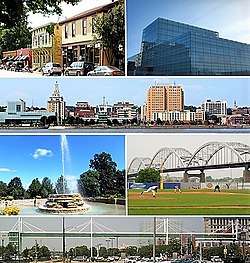 Top row: Village of East Davenport, Figge Art Museum; Second row: Downtown Davenport, Third row: Fountain in Vander Veer Botanical Park, baseball in Modern Woodmen Park; Bottom row: Davenport Skybridge | |
 Flag | |
| Nickname(s): Iowa's Front Porch[1] | |
| Motto(s): Working together to serve you | |
 Location of Davenport in Scott County (left) and location of Scott County in the State of Iowa | |
 Davenport, Iowa Location in the United States  Davenport, Iowa Davenport, Iowa (the United States)  Davenport, Iowa Davenport, Iowa (North America) | |
| Coordinates: 41°32′35″N 90°35′27″W | |
| Country | |
| State | |
| County | Scott |
| Settled | May 14, 1836 |
| Incorporated | January 25, 1839 |
| Government | |
| • Type | Mayor–council |
| • Mayor | Mike Matson |
| Area | |
| • City | 65.94 sq mi (170.79 km2) |
| • Land | 63.82 sq mi (165.29 km2) |
| • Water | 2.12 sq mi (5.50 km2) |
| Elevation | 580 ft (180 m) |
| Population | |
| • City | 99,685 |
| • Estimate (2019)[4] | 101,590 |
| • Rank | 3rd in Iowa (US: 296th) |
| • Density | 1,591.82/sq mi (614.61/km2) |
| • Metro | 382,630 (135th) 474,226 (90th) |
| Time zone | UTC−6 (CST) |
| • Summer (DST) | UTC−5 (CDT) |
| ZIP codes | 52801–52809 |
| Area code(s) | 563 |
| FIPS code | 19-19000 |
| Interstates | |
| Waterways | Mississippi River |
| Website | www |
Located approximately halfway between Chicago and Des Moines, Davenport is on the border of Iowa across the river from Illinois. The city is prone to frequent flooding due to its location on the Mississippi River. There are two main universities: St. Ambrose University and Palmer College of Chiropractic, where the first chiropractic adjustment took place. Several annual music festivals take place in Davenport, including the Mississippi Valley Blues Festival, the Mississippi Valley Fair, and the Bix Beiderbecke Memorial Jazz Festival. An internationally known 7-mile (11 km) foot race, called the Bix 7, is run during the festival. The city has a Class A minor-league baseball team, the Quad Cities River Bandits. Davenport has 50 plus parks and facilities, as well as more than 20 miles (32 km) of recreational paths for biking or walking.
Three interstates, 80, 74 and 280, and two major United States Highways serve the city. Davenport has seen steady population growth since its incorporation. National economic difficulties in the 1980s, resulted in job and population losses. The Quad Cities was ranked as the most affordable metropolitan area in 2010 by Forbes magazine. In 2007, Davenport, along with neighboring Rock Island, won the City Livability Award in the small-city category from the U.S. Conference of Mayors. In 2012, Davenport, and the Quad Cities Metropolitan Area, was ranked among the fastest-growing areas in the nation in the growth of high-tech jobs.[10] Notable natives of the city have included jazz legend Bix Beiderbecke, Pulitzer Prize-winning playwright Susan Glaspell, former National Football League running back Roger Craig, UFC Welterweight Champion Pat Miletich, and former two time WWE Champion and WWE Universal Champion Seth Rollins.
History
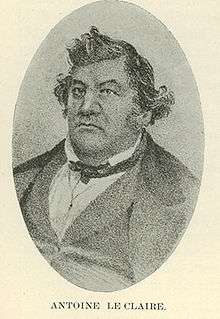
The land was originally owned by the historic Sauk people, Meskwaki (Fox), and Ho-Chunk (Winnebago) Native American tribes. France laid claim to this territory as part of its New France and Illinois Country in the 18th century. Its traders and missionaries came to the area from Canada (Quebec), but it did not have many settlers here. After losing to Great Britain in the Seven Years' War, France ceded its territory east of the Mississippi River to the victor, but retained lands to the west.
In 1803 France sold its holdings in North America west of the Mississippi River to the United States under the Louisiana Purchase. Lieutenant Zebulon Pike was the first United States representative to officially visit the Upper Mississippi River area. On August 27, 1805, Pike camped on the present-day site of Davenport.[11]
In 1832, a group of Sauk, Meskwaki, and Kickapoo people were defeated by the United States in the Black Hawk War. The United States government concluded the Black Hawk Purchase, sometimes called the Forty-Mile Strip or Scott's Purchase, by which the US acquired lands in what is now eastern Iowa. The purchase was made for $640,000 on September 21, 1832 and contained an area of some 6 million acres (24,000 km2), at a price equivalent to 11 cents/acre (26 $/km2). Although named after the defeated chief Black Hawk, he was being held prisoner by the US. Sauk chief Keokuk, who had remained neutral in the war, signed off on the purchase. It was made on the site of present-day Davenport. Army General Winfield Scott and Governor of Illinois, John Reynolds, acted on behalf of the United States, with Antoine Le Claire, a mixed-race (Métis) man, serving as translator. He later was credited with founding Davenport.
Chief Keokuk gave a generous portion of land to Antoine Le Claire's wife, Marguerite, the granddaughter of a Sauk chief. Le Claire built their home on the exact spot where the agreement was signed, as stipulated by Keokuk, or he would have forfeited the land. Le Claire finished the 'Treaty House' in the spring of 1833. He founded Davenport on May 14, 1836, naming it for his friend Colonel George Davenport, who was stationed at Fort Armstrong during the war. The city was incorporated on January 25, 1839.[12] The area was successively governed by the legislatures of the Michigan Territory, the Wisconsin Territory, Iowa Territory and finally Iowa.
Scott County was formed by an act of the Wisconsin Territorial legislature in 1837.[13] Both Davenport and its neighbor Rockingham campaigned to become the county seat. The city with the most votes from Scott County citizens in the February 1838 election would become the county seat. On the eve of the election, Davenport citizens acquired the temporary service of Dubuque laborers so they could vote in the election. Davenport won the election with the help of the laborers. Rockingham supporters protested the elections to the territorial governor, on the grounds the laborers from Dubuque were not Scott County residents. The governor refused to certify the results of the election. A second election was held the following August. To avoid another import of voters, the governor set a 60-day residency requirement for all voters. Davenport won by two votes. Because the margin of victory was so close, a third election was held in the summer of 1840. As the August election drew nearer, Rockingham residents grew tired of the county seat cause. Davenport easily won the third election. Consequently, to avoid questions about the county seat, Davenport quickly built the first county courthouse.[14]
The Rock Island Railroad built the first railroad bridge across the Mississippi River in 1856. It connected Davenport to Rock Island, Illinois.[15] This railway connection resulted in significant improvements to transportation and commerce with Chicago, a booming 19th-century city. The addition of new railroad lines to Muscatine and Iowa City, and the acquisition of other lines by the Rock Island Railroad, resulted in Davenport becoming a commercial railroad hub.[11]

Steamboat companies rightly saw nationwide railroads as a threat to their business. On May 6, 1856, just weeks after the bridge was completed, a steamboat captain deliberately crashed the Effie Afton into the bridge. The owner of the Effie Afton, John Hurd, filed a lawsuit against the Rock Island Railroad Company. Abraham Lincoln was the lead defense lawyer for the railroad company.[15] The decision of the United States Supreme Court upheld the right to bridge navigable streams, therefore the bridge was allowed to remain.[16]

Prior to the start of the Civil War, Governor Samuel J. Kirkwood declared Davenport to be Iowa's first military headquarters; five military camps were set up in the city to aid the Union.[18]
The Davenport City Hall was built in 1895 for price of $100,000 ($3.07 million in 2019 dollars). [19] Architectural journals of the time poked fun at the project due to the small amount of money budgeted.[20] The skyline began forming in the 1920s with the construction of the Kahl Building, the Parker Building, and the Capitol Theatre during a period of economic and building expansion.
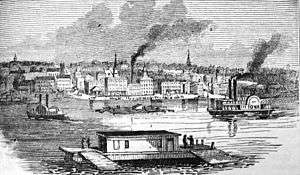
By 1932, thousands of Davenport residents were on public relief, due to the Great Depression. A shantytown of the poor developed in the west end of the city, along the Mississippi River. Sickness, hunger, and unsanitary living conditions plagued the area.
The situation would soon change, as many citizens went to work for the Works Progress Administration. Davenport had an economic boom during and after World War II, driven by wartime industry and peacetime demand. As Davenport grew, it absorbed smaller surrounding communities, annexing Rockingham, Nahant, Probstei, East Davenport, Oakdale, Cawiezeel, Blackhawk, Mt. Joy, Green Tree, and others. Oscar Mayer, Ralston Purina, and other companies built plants in west Davenport. The Interstate highway network reached Davenport in 1956, improving transportation in the area. By 1959, more than 1,000 homes a year were being constructed.
By the late 1970s, the good times were over for both downtown and local businesses and industries. Railroad restructuring in the mid-20th century had caused a loss of jobs in the industry. The farm crisis of the 1980s negatively affected Davenport and the rest of the Quad Cities, where a total of 35,000 workers lost their jobs throughout the entire Quad Cities area.[21] Restructuring of heavy industry also continued: the Caterpillar plant on the city's north side closed, causing another wave of job loss.[21]
With the 1990s, the city finally showed the beginnings of a resurgence.[21] In the early 21st century, many renovations and building additions have occurred to revitalize the downtown area, including repairing Modern Woodmen Park, the building of the Skybridge and the Figge Art Museum. In 2011, the Gold Coast and Hamburg Historic District was named as a 2011 "America's Great Place" by the American Planning Association.[22]
Geography
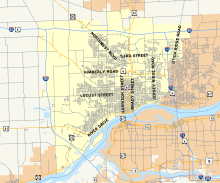
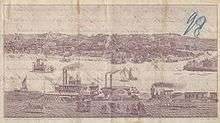
Davenport's longitude and latitude coordinates in decimal form are 41.542982, −90.590745.[23] According to the United States Census Bureau, the city has a total area of 65.08 square miles (168.56 km2), of which 62.95 square miles (163.04 km2) is land and 2.13 square miles (5.52 km2) is water.[24] Davenport is located approximately 170 miles (270 km) west of Chicago and 170 miles (270 km) east of the Iowa state capital of Des Moines. The city is located about 200 miles (320 km) north of St. Louis, Missouri, and 265 miles (426 km) southeast of Minneapolis, Minnesota. Farmland surrounds Davenport, outside the Quad Cities area.
Davenport is located on the banks of the Mississippi River. At this point the river has a maximum depth of around 30 to 40 feet (9.1 to 12.2 m) and is 2,217 feet (676 m) wide where the Centennial Bridge crosses it. The river flows from east to west in this area, as opposed to its usual north to south direction.[25] From the river the city starts to slope north up a hill, which is steep at some points. The streets of the city, especially downtown and in the central part of the town, follow a grid design.
Davenport often makes national headlines when it suffers seasonal flooding by the Mississippi River.[26] It is the largest city bordering the Mississippi that has no permanent flood wall or levee.[27] Davenport residents prefer to maintain open access to the river for parks and vistas rather than have it cut off by dikes and levees. Davenport has adopted ordinances requiring any new construction in the floodplain to be elevated above the 100-year-flood level, or protected with walls. As a result, former mayor Phil Yerington said that if they "let Mother Nature take her course, we'll all be better off".[26] An example of a Davenport building that is elevated or flood-proofed is the Figge Art Museum.[28]
Climate

Under the Köppen climate classification, Davenport is considered to have a humid continental climate (Dfa). Summers are very warm to hot with high levels of humidity. Winters have cold temperatures and often high winds, with snow likely from November through February. Average snowfall in Davenport is 30.7 inches (780 mm) per year.[29] January is on average the coldest month, while July is the warmest.[30] The highest temperature recorded in Davenport was 111 °F (44 °C) on July 12, 1936.[31] The lowest temperature, −29 °F (−34 °C), was recorded on January 18, 2009.[32] Substantial weather changes frequently occur at three- to four-day intervals as a result of mid-latitude storm tracks, which is where low and high pressure extratropical disturbances occur.[33][34]
Although several minor tornadoes have occurred, no devastating tornado has ever touched down in Davenport.[35] Flooding, however, is often a problem in Davenport due to the lack of a flood wall. During the Great Flood of 1993, the water crested at 22.63 feet (6.90 m) on July 9.[36] This is nearly 8 feet (2.4 m) above the 14.9-foot (4.5 m) flood stage. Major flooding in Davenport causes many problems. Roads in and around the downtown area, including U.S. Route 67, are closed and cause increased traffic on other city roads. The effects of major flooding can be long-lasting. For example, during the 2008 flooding, Credit Island in the city's southwest corner remained closed for 5½ months while crews worked on cleaning up damage and removing river debris.[37] Duck Creek, a stream situated in Bettendorf and Davenport, is also vulnerable to flash flooding. Severe thunderstorms on June 16, 1990, created heavy flash flooding in Bettendorf and Davenport that killed four people.[38] Another major flood happened on June 12, 2008, when severe thunderstorms caused Duck Creek to overflow its banks and flood properties and nearby streets (see Iowa flood of 2008).[39]
| Climate data for Quad Cities (Quad City International Airport), 1981–2010 normals, extremes 1871–present[lower-alpha 1] | |||||||||||||
|---|---|---|---|---|---|---|---|---|---|---|---|---|---|
| Month | Jan | Feb | Mar | Apr | May | Jun | Jul | Aug | Sep | Oct | Nov | Dec | Year |
| Record high °F (°C) | 69 (21) |
74 (23) |
88 (31) |
93 (34) |
104 (40) |
104 (40) |
111 (44) |
106 (41) |
100 (38) |
95 (35) |
80 (27) |
71 (22) |
111 (44) |
| Average high °F (°C) | 31.0 (−0.6) |
35.7 (2.1) |
48.8 (9.3) |
62.3 (16.8) |
72.9 (22.7) |
82.3 (27.9) |
85.8 (29.9) |
83.8 (28.8) |
76.8 (24.9) |
64.1 (17.8) |
49.2 (9.6) |
34.6 (1.4) |
60.7 (15.9) |
| Average low °F (°C) | 14.3 (−9.8) |
18.3 (−7.6) |
29.4 (−1.4) |
40.5 (4.7) |
50.7 (10.4) |
60.7 (15.9) |
65.0 (18.3) |
63.2 (17.3) |
53.9 (12.2) |
42.4 (5.8) |
30.9 (−0.6) |
18.6 (−7.4) |
40.8 (4.9) |
| Record low °F (°C) | −33 (−36) |
−28 (−33) |
−19 (−28) |
7 (−14) |
25 (−4) |
39 (4) |
46 (8) |
40 (4) |
24 (−4) |
11 (−12) |
−10 (−23) |
−24 (−31) |
−33 (−36) |
| Average precipitation inches (mm) | 1.49 (38) |
1.60 (41) |
2.86 (73) |
3.59 (91) |
4.32 (110) |
4.49 (114) |
4.29 (109) |
4.52 (115) |
3.09 (78) |
2.97 (75) |
2.56 (65) |
2.18 (55) |
37.96 (964) |
| Average snowfall inches (cm) | 9.4 (24) |
6.8 (17) |
4.0 (10) |
0.9 (2.3) |
0 (0) |
0 (0) |
0 (0) |
0 (0) |
0 (0) |
0 (0) |
1.2 (3.0) |
9.3 (24) |
31.6 (80) |
| Average precipitation days (≥ 0.01 in) | 8.8 | 8.3 | 10.1 | 11.0 | 11.7 | 10.5 | 9.8 | 9.8 | 8.2 | 9.1 | 9.8 | 10.0 | 117.1 |
| Average snowy days (≥ 0.1 in) | 7.1 | 5.6 | 3.2 | 0.7 | 0 | 0 | 0 | 0 | 0 | 0 | 1.7 | 6.8 | 25.1 |
| Average relative humidity (%) | 69.9 | 69.8 | 68.3 | 64.3 | 64.9 | 65.8 | 70.5 | 73.3 | 72.8 | 68.1 | 71.3 | 74.0 | 69.4 |
| Mean monthly sunshine hours | 148.1 | 153.8 | 180.5 | 210.1 | 255.1 | 284.6 | 301.9 | 271.4 | 222.0 | 192.9 | 121.7 | 113.9 | 2,456 |
| Percent possible sunshine | 50 | 52 | 49 | 53 | 57 | 63 | 66 | 63 | 59 | 56 | 41 | 40 | 55 |
| Source: NOAA (relative humidity and sun 1961−1990)[40][41][42] | |||||||||||||
Neighborhoods
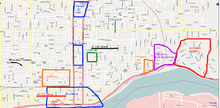

Davenport has several neighborhoods dating back to the 1840s.[43] The original city plot was around current day Ripley and 5th Streets, where Antoine Le Claire had built his house. The city can be divided into five areas: downtown, central, east end, near north and northwest, and west end. Many architectural designs are found throughout the city including Victorian, Queen Anne, Tudor Revival, and others.[44] Many of the original neighborhoods were inhabited by German settlers.[43]
The east side of the city dates back to 1850 and has always contained higher end housing. The proximity and commanding view of the river kept these neighborhoods a fashionable address, long after the original families departed.[45] Lindsay Park, in The Village of East Davenport, was used as parade grounds for Civil War soldiers from Camp McClellan.[18]
In contrast to the east side, the central and west neighborhoods originally contained many of the working class Germans who settled the town. Development on the west side started in the 1850s, with extensive construction occurring in the 1870s.[46] Housing was mostly one and a half to two story front gable American Foursquare and simplified Queen Anne style. The central Hamburg neighborhood, now known as the Hamburg Historic District, contains the most architecturally significant residences in the old German neighborhoods.[47] Also in central Davenport, the Vander Veer Park Historic District is a neighborhood anchored by Vander Veer Park, a large park with a botanical garden and a fountain. The park was modeled after New York City's Central Park and originally shared its name.[48] Vander Veer is surrounded by large Queen Anne and Tudor Revival style houses that were built between 1895 and 1915. Development of the Vander Veer Park was one of the first major beautification efforts.[48]
Today, the eastern side of Davenport still contains many of the higher class houses in the city. The old Civil War parade grounds, in The Village of East Davenport ("The Village" for short), have been turned into Lindsay Park, which is surrounded by small specialty shops. West of The Village, Downtown contains the two tallest buildings in the Quad Cities; the Wells Fargo Bank Building, which is 255 feet tall, and the Mid-American Energy Building, which is 220 feet tall.[49] Other tall buildings include the 11-story Hotel Blackhawk, the 150 foot Kahl Building and the Davenport City Hall.[50]
Government
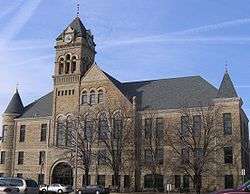
Davenport uses a mayor–council form of local government. As of 2016, city government consists of mayor Frank Klipsch and a ten-person council. One person is elected from each of the eight wards and two at-large aldermen are elected to represent the whole city.[51] Nonpartisan elections are held in odd-numbered years. The mayor is top elected individual for the city. The mayor's duties include running city council meetings and approves or vetoes all actions taken by the council members, and can vote in case of a tie. He or she also appoints city board members.[52] The city council's job is to make laws and set the city budget.[53] The city administrator, currently (no permanent administrator), is appointed by the mayor with confirmation by two-thirds of the council. Citywide goals through 2012 include having a financially responsible government, having a growing economy, revitalizing neighborhoods, and upgrading city infrastructure and public facilities.[54] The establishment of Davenport as a political and government unit came in 1839, three years after the city was settled.[55] The city was incorporated as a result of a resolution by Iowa Representative Jonathan W. Parker by special charter in the Iowa Territory on January 25, 1839.[55] Parker was a resident of Davenport and one of six trustees elected to govern the city with Rodolphus Bennet being the first mayor. Activity for the first four months was minimal as the council failed to meet.[55] In 1842, the city charter was amended for the first time. Changes include having six alderman replace the five trustees, dividing the city into three wards, and appointing a city clerk position to replace the recorder.[55] The charter was amended again in 1851 to expand the city area, provide greater detail of the duties of the mayor, city council, and other officials.[55] During the last half of the 19th century, government assumed expanding responsibilities for public welfare and public works improvements.
The city expanded police protection, even temporarily having volunteer police officers to assist the three paid officers.[55] Fire protection was expanded in 1882, with the city's first 13 paid firefighters.[55] Former mayor Henry Vollmer accomplished several public works achievements, including large street paving and new sub-divisions being plotted.[55] A large city budget surplus brought the creation of the Davenport City Hall.[56] After 1900, each mayor brought new agendas for city improvement. Waldo Becker encouraged new railroads for the city. He also promised a more business-like government, in terms of financial responsibility and to depoliticize the police department. In the mid-1920s the city established the first zoning ordinances, electrical traffic signals and street lighting. The city also expanded with the incorporation of the city of Rockingham and the establishment of the Davenport Municipal Airport.[56]
The 2010 fiscal year budget was $199.2 million,[57] an increase of $35 million from 2009.[57] The city's general fund receives the largest amount of funds from property taxes, followed by service fees such as solid waste collection and swimming pool or golf course admission and 80% of its expenses go to personnel costs.[57] The city has given a few surveys for citizens to rate the quality of life and city services. The largest department in the city is the public works department with a budget of $36.7 million.[57] The police department is second with a budget of $22.4 million, while the fire department has a budget of $15 million.[57] The parks department has $6.1 million, and the Davenport Public Library has a $3.8 million budget.[57]
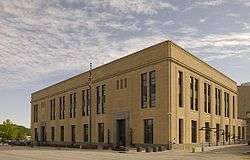
At the federal level, Davenport is in Iowa's 2nd congressional district. As of 2013, it is represented by Democrat Dave Loebsack. The two Senators are Republicans Chuck Grassley and Joni Ernst. At the state level, Davenport is represented by the 41st, 42nd, and 43rd Iowa Senate districts and in the Iowa House of Representatives by the 81st, 84th, 85th, and 86th districts.
As of 2012, the 41st senate district covers the eastern third of the city and all of Bettendorf, Riverdale, and Panorama Park. It is more conservative then other Davenport districts being represented by a Republican since the 1970s. The district is slightly moving more liberal with an increase of 3,000 Democrats between 2006 and 2010.[58] The district is represented by Republican Senator Roby Smith.[59] The 42nd district covers the western third of the city along with all of Scott County that is not in Davenport, Bettendorf, Riverdale, or Panorama Park as well as western and southern rural Clinton County and is represented by Republican Senator Shawn Hamerlinck.[60] The 43rd senate district covers the central third of the city and is represented by Democrat Joe Seng.[61]
The 81st house district covers the eastern third of the city along with small western portion of Bettendorf. The district shares the same western boundaries as the forty-first senate district. The district is represented by Democrat Phyllis Thede.[62] The 84th district covers the western third of the city, and has the same eastern boundary as Senate district forty-two and is represented by Republican Ross Paustian.[63] The 85th and 86th districts are made up of the same area as the forty-third senate district. The 85th district covers the north and west-central area while the 86th district covers southern and eastern part of the senate district.[64][65] Both are represented by Democrats with Jim Lykam representing the 85th and Cindy Winckler representing the 86th.
Davenport has a Federal Court House for the United States District Court for the Southern District of Iowa.
Demographics
| Historical population | |||
|---|---|---|---|
| Census | Pop. | %± | |
| 1850 | 1,848 | — | |
| 1860 | 11,267 | 509.7% | |
| 1870 | 20,038 | 77.8% | |
| 1880 | 21,831 | 8.9% | |
| 1890 | 26,872 | 23.1% | |
| 1900 | 35,254 | 31.2% | |
| 1910 | 43,028 | 22.1% | |
| 1920 | 56,727 | 31.8% | |
| 1930 | 60,751 | 7.1% | |
| 1940 | 66,039 | 8.7% | |
| 1950 | 74,549 | 12.9% | |
| 1960 | 88,981 | 19.4% | |
| 1970 | 98,469 | 10.7% | |
| 1980 | 103,264 | 4.9% | |
| 1990 | 95,333 | −7.7% | |
| 2000 | 98,359 | 3.2% | |
| 2010 | 99,685 | 1.3% | |
| Est. 2019 | 101,590 | [4] | 1.9% |
| U.S. Decennial Census[66] | |||
According to the 2010 United States Census estimate, the city population grew to 99,685 and the Quad Cities metropolitan area grew to 379,690.[67] As of the 2000 census, there were 98,359 people, 39,124 households, and 24,804 families residing in the city. The population density was 1,566.5 people per square mile (604.8/km2). There were 41,350 housing units at an average density of 658.5 per square mile (254.3/km2). Davenport's population density was 30 times the average density of Iowa and 20 times the average density of the United States.[68][69] However, it was about a third less than Des Moines and 20 percent less than Cedar Rapids, the only two cities in Iowa with higher populations than Davenport. Sioux City, the next city smaller than Davenport in population, had a density of 5 people more per square mile.[68][69]
The racial makeup of the area was 83.7% White (410,861), 11.43% Black or African American (27,757), 0.4% American Indian and Alaskan Native (1,255), 2.0% Asian (6,624), 0.03% Pacific Islander (156), and 2.0% from two or more races (11,929). 7.1% of the population was Hispanic or Latino of any race (37,070).[70] There were 39,124 households out of which 31.8% had children under the age of 18 living with them, 46.0% were married couples living together, 13.4% had a female householder with no husband present, and 36.6% were non-families. Of all households, 29.5% were made up of individuals and 9.4% had someone living alone who was 65 years of age or older. The average household size was 2.44 and the average family size was 3.03.[70]
Davenport is less white than the rest of Iowa on average, as well as the United States.[71]
Age spread: 26.2% under the age of 18, 10.7% from 18 to 24, 30.1% from 25 to 44, 20.9% from 45 to 64, and 12.1% who were 65 years of age or older. The median age was 34 years. For every 100 females, there were 94.7 males.[70][72]
Economy
Davenport's biggest labor industry is manufacturing, with over 7,600 jobs in the sector.[73] John Deere is the second largest employer in the Quad Cities, after the Rock Island Arsenal as a whole. Deere, however, is the largest single employer, employing 7,200 workers in the Quad Cities and 948 on its north side Davenport plant.[57][74] John Deere World Headquarters is located in Moline. Other large employers in Davenport and the Quad Cities include, Genesis Health System with 5,125 employees and 4,900 in Davenport, Trinity Regional Health System with 3,333, regional grocery store Hy-Vee with 3,138 and the Davenport Community School District with 2,237 employees.[74]
Davenport is the headquarters for department store Von Maur, which has 24 stores.[75] Davenport is also the headquarters of Lee Enterprises, which publishes fifty daily newspapers and more than 300 weekly newspapers, shoppers, and specialty publications, along with online sites in 23 states.[76] As of September 2009, the unemployment rate in Davenport and the rest of the Quad Cities, had risen to 8.4%.[77]
The median income for a household in the city was $40,378, with families earning $51,445.[78] Males had a median income of $41,853 versus $30,002 for females.[78] The per capita income for the city was $18,828. About 10.5% of families and 14.1% of the population were below the poverty line, including 19.2% of those under age 18 and 6.4% of those ages 65 or over.
Davenport has a lower cost of living than the national average, in 2010 the average home price was $110,000; Forbes ranked Davenport as the best metropolitan area for cost of living, up from second in 2009.[79][80] CNN Money ranked Davenport as the 16th most affordable housing in the country.[81]
The surrounding Quad Cities have a few major places of employment, including the Rock Island Arsenal, which is the largest government-owned weapons manufacturing arsenal in the United States.[82] KONE, Inc, a large manufacturer of elevators, is located in Moline, Illinois. Alcoa, a large aluminum manufacturer, is located in Riverdale, Iowa. Other local businesses include Whitey's Ice Cream, Hungry Hobo sandwich shop, and Happy Joe's and Harris Pizza – both local pizzerias (the former of which is also an ice cream parlor).
Arts and culture
Landmarks
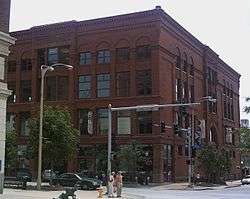
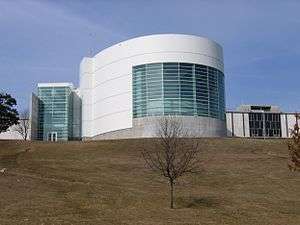
Downtown Davenport has many points of interest including the Davenport Public Library, the Davenport Skybridge, Figge Art Museum, River Music Experience, Putnam Museum, the RiverCenter/Adler Theater, Modern Woodmen Park which is home of the Quad City River Bandits baseball team and the Centennial Bridge. The former Chicago, Milwaukee, St. Paul and Pacific Freight House, now known as The Freight House, is home to several small businesses featuring locally grown items, such as a deli, a grocery hub, and a tap room for a local brewery.

Davenport's cultural and educational institutions include the Figge Art Museum, which houses The National Center for Midwest Art and Design, and was founded in 1925 as the Davenport Municipal Art Gallery.[84][85] The Putnam Museum, which was founded in 1867 and was one of the first museums west of the Mississippi River.[86] The Quad City Symphony Orchestra, headquartered in downtown Davenport, was founded in 1915.[87] The Davenport Public Library was opened in 1839.[88] The German American Heritage Center is located at the foot of the Centennial Bridge.
Uptown features a few historic landmarks such as the Iowa Soldiers' Orphans' Home which took in homeless children from all of Iowa's ninety-nine counties following the Civil War[89] and Ambrose Hall which was the original building of St. Ambrose University.[90] Aside from landmarks, uptown contains some entertainment venues too, such as the Great Mississippi Valley Fairgrounds, which hosts fairs, stock car racing, and many other events. NorthPark Mall is the city's main shopping mall and has 160 stores. Its companion, SouthPark Mall, is located in Moline. Brady Street Stadium is home to Davenport high school and Saint Ambrose University football games. Davenport has a number of parks, including Credit Island park which has a bike path, baseball diamonds, tennis courts, and fishing along the Mississippi River. Vander Veer Botanical Park has a small botanical garden and also features a walking path, a lagoon, and a large fountain.[91] The Stampe Lilac Garden is located in Duck Creek Park, on Locust St.
Additional Parks and Recreation amenities: • 50+ parks and facilities • 25+ picnic areas and shelters • 20+ miles of recreational trails • 2 dog off leash parks • Multiple natural prairies and no-mow zones • 32 playgrounds • 30 ball diamonds • 17 outdoor basketball courts • 8 tennis/pickle ball courts • 8 volleyball courts • 3 golf courses • FootGolf course (Red Hawk Golf Course) • 3 disc golf courses • 8 river views • Multiple lagoons and pond • Various fishing locations including 3 boat launches • 3 pools • Spray park • 3 splash pads • Soccer complex • Indoor ice and turf facility (The River's Edge) • Skate park • Iowa's only indoor human foosball (The River's Edge) • Mobile environmental education trailer • Mobile show wagon • Botanical park and conservatory • 5 fountains • 2 lodges • Cemetery • Community center • Several historic sites including a bandshell • The second oldest children's theatre in America (Junior Theatre)
Events and festivals
Bix Fest is a three-day music festival with many traditional jazz bands held in tribute to internationally renowned jazz cornetist, pianist, composer, and Davenport native Bix Beiderbecke. The festival was started in August 1971 and the Bix Beiderbecke Memorial Society was founded one year later to organize and sponsor it.[92] 2009 was the 39th consecutive festival. In addition to the Bix Fest, the Wells Fargo Street Fest features live music, food, and vendors.
The annual Bix 7 is a 7-mile (11 km) road race held in late July in Davenport. The race was founded in 1975 by John A. Hudetz a resident of Bettendorf, Iowa, who wanted to bring to the Quad Cities some of the excitement he felt when he ran his first Boston Marathon.[93] The first race had 84 participants, but today 12,000 to 18,000 runners take part.[93][94][95] In late July or early August the six-day Great Mississippi Valley Fair features major grandstand concerts, carnival rides, attractions, and food vendors.[96] Sturgis on the River is a large annual gathering of motorcycles which includes bands and food vendors.[97] Other local expositions include River Roots Live, Beaux Arts Fair and many others.
Sister cities
Davenport has four sister cities:[98][99]




Livability Award
Davenport (along with neighboring Rock Island, Illinois), won the 2007 City Livability Award in the small-city category from the U.S. Conference of Mayors. Tom Cochran, Executive Director of the Conference, stated that the award "gives the Conference a chance to highlight mayoral leadership in making urban areas safer, cleaner and more livable."[100] The award acknowledges achievements from the RiverVision plan of Davenport and Rock Island.[101]
Sports and recreation
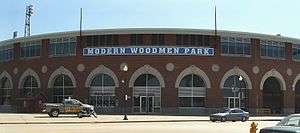
Davenport and the Quad Cities are home to many sports teams. The Quad Cities River Bandits baseball team play games at Downtown Davenport's Modern Woodmen Park. The TaxSlayer Center in Moline is home the Quad City Steamwheelers indoor football team and the Quad City Storm hockey team. Davenport high schools are in the Mississippi Athletic Conference for sports.
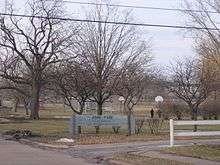
Davenport has over fifty parks or recreational trails.[102] Major parks include Credit Island, which is a 450-acre (1.8 km2) park in southwest Davenport located alongside the Mississippi River.[102] Fejervary Park contains a pool and has had approximately 20,000 visitors each year since 1996.[102] Junge Park is situated along the Duck Creek Parkway and includes baseball and softball fields, sand volleyball, and basketball courts.[102] LeClaire Park is located right on the banks of the Mississippi River next to Modern Woodmen Park. LeClaire Park hosts many summer events including River Roots Live and Ribfest.[103] Bands for the Bix Fest play in the park each July. Vander Veer Botanical Park welcomes approximately 25,000 visitors to continuous floral shows.[102]
The city features two recreational trails for biking or walking. Duck Creek Parkway extends from Emeis Park in west Davenport 8.26 miles (13.29 km) east to Bettendorf along Duck Creek. Riverfront Parkway extends 4.75 miles (7.64 km) along the Mississippi waterfront from Credit Island to Bettendorf. Both these trails continue into Bettendorf.[102] Plans are being discussed to connect the two trails in Riverdale.[104] Three public golf courses are offered in the city.[105] For river-related activities, The Channel Cat boat offers rides across the river and has two stops in Iowa and three stops in Illinois and connects the bike paths that each state has on its river front.[106]
Davenport is also home to Daytrotter, a recording studio and venue which has hosted and recorded many different indie-rock bands throughout the country. Daytrotter is located at 324 Brady Street in the heart of downtown Davenport.
Media

There are two major daily newspapers in Davenport. The Quad-City Times is based out of Davenport and The Dispatch/Rock Island Argus is based out of Moline. An alternative free newspaper, the River Cities' Reader, is published in Davenport. All four major television networks have stations in the area, including KWQC (NBC) and KLJB (Fox) in Davenport. WHBF (CBS) is located in Rock Island and WQAD (ABC) is in Moline.
The Quad Cities ranks as the 97th largest market for television[107] and the 147th largest market for radio.[108] Radio station WOC made its local broadcasting debut on February 18, 1922. It was the second licensed station on the air.[109] In 1933 WOC hired future president Ronald Reagan as a staff announcer.[109]
Film, theater, and literary references
- Bix Beiderbecke recorded a song in 1925 called "Davenport Blues".
- The 1958 Johnny Cash song, "Big River", also later recorded by Bill Monroe and other artists, mentions "cavortin' in Davenport."
- Davenport is one of eight cities listed in the song "Iowa Stubborn" from the 1957 musical The Music Man.
- Davenport during and following the 1993 flood is a playable scenario in Sim City 2000 Scenarios Volume 1: Great Disasters.[110]
Education

Davenport public schools serve nearly 17,000 students in the communities of Davenport, Blue Grass, Buffalo, and Walcott. The Davenport Community School District is the second-largest school district in Iowa.[111] Davenport has four public high schools: Central, West, Mid City[112] and North and one private high school: Assumption. There are six public intermediate schools and 23 public elementary schools.[113] Sudlow, one of the intermediate schools, was named after Phebe Sudlow, the first female public school superintendent in the United States.[114] She was superintendent for Davenport schools from 1874 to 1878.[114] The high schools are part of the Mississippi Athletic Conference for sports.
The city has four colleges and universities: Saint Ambrose University, established in 1882, is the oldest; Kaplan University, Palmer Chiropractic College, and Hamilton Technical College. Palmer College is the first chiropractic school and the site of the first chiropractic adjustment in the world.[115][116][117]
Marycrest International University was a university in Davenport from 1939 to 2002, when it closed. The campus was renovated and adapted to senior citizen housing.[118]
Infrastructure
Transportation
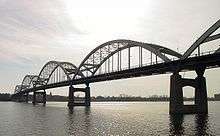
Three interstate highways serve Davenport: Interstate 80, Interstate 280, and Interstate 74. Interstate 88 serves the Illinois Quad Cities and runs east to Chicago. U.S. Route 6, U.S. Route 61, and U.S. Route 67 also go through Davenport; U.S. 67 crosses over to Illinois via the Rock Island Centennial Bridge. Davenport is connected to the Illinois side of the Quad Cities by a total of three bridges across the Mississippi River. The Government Bridge and the Centennial Bridge connect Downtown Davenport with the Rock Island Arsenal and downtown Rock Island, respectively. The I-280 Bridge connects the western edge of Davenport with the western edge of Rock Island.
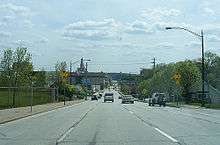
Other highways include Iowa Highway 22, which is on the city's southwest side, and Iowa Highway 130, which runs along Northwest Boulevard on Davenport's north edge. For air travel, Davenport Municipal Airport – located adjacent to the city's northern city limits – serves smaller aircraft, and is the home of the annual Quad City Airshow. The Quad City International Airport across the river in Moline, Illinois, is the closest commercial airport. Major railroads include the Iowa Interstate Railroad and the Iowa, Chicago and Eastern. Two national U.S. recreation trails intersect in Davenport: the Mississippi River Trail and the American Discovery Trail.
Amtrak currently does not serve Davenport or the Quad Cities. The closest station currently is about 50 miles (80 km) away in Galesburg, Illinois. In 2008, the two current United States Senators from Iowa, Tom Harkin and Chuck Grassley, Illinois Senator Dick Durbin, and former Senator Barack Obama sent a letter to Amtrak asking them to begin plans to bring rail service to the Quad Cities.[119] In October 2010, a $230 million federal fund was announced that will bring Amtrak service to the Quad Cities, with a new line running from Moline to Chicago. They had hoped to have the lined completed in 2015, and offer two round trips daily to Chicago.[120] Currently the Moline station does not have any Amtrak service. Greyhound Lines/Burlington Trailways bus service has a station in Davenport. The building is shared with the local Davenport Citibus.[121] Davenport does not have any river ports.
Davenport has an infamous "truck-eating bridge".[122] The bridge, or rather three bridges, is a set of railroad bridges that cross over north and southbound U.S. Route 61 and another street. Every year an average of 12 semi trucks hit the bridge, usually causing massive damage to the trucks.[122] The bridges, made out of iron, steel, and concrete, are rarely damaged.[122]
Davenport Citibus
Public transit appeared in Davenport in 1969 when the city created a City Transit Authority.[121] The authority at first provided monetary support to Davenport City Lines Bus Company, which was a privately owned company. After a few years the city purchased the Davenport City Lines and placed the operation of public transportation under the jurisdiction of the City's Department of Municipal Transportation. Today, CitiBus is a division of the Department of Public Works. CitiBus has a total of 20 vehicles and covers approximately 30 square miles (78 km2) of the city. CitiBus connects with both Bettendorf Transit and the Illinois Quad Cities mass transit system, MetroLINK.[121] In 2007 Citibus saw a ridership of 1,022,815 customers. Ridership as of September 2008 had grown to 1,045,000 due in part to high gas prices.[123]
Utilities

Electricity to Davenport, and the rest of the Iowa Quad Cities, is provided by MidAmerican Energy Company. Water is provided by the Mississippi River and is treated by the Iowa American Water Company. The water treatment facility is located in southeast Davenport.
Health care
Davenport is served by two hospitals: Genesis Medical Center East – Rusholme Street and Genesis Medical Center – West Central Park Avenue part of the Genesis Health System. Together the facilities, along with two other facilities outside Davenport have 665 beds.[124] The hospitals employ more than 600 physicians and 5,000 staff members.[124] The American Nurses Credentialing Center, awarded Genesis Medical Center the Magnet designation for excellence in nursing services.[125] Fewer than three percent of hospitals receive this honor.[125]
Notable people
Notable Davenporters include jazz musician Bix Beiderbecke, after whom the Bix 7 road race and jazz festival are named.[126] The artist Isabel Bloom was raised in Davenport; she is the creator of decorative concrete figurines that bear her name.[127][128]
Guitarist and vocalist John Kadlecik, who founded The Dark Star Orchestra and toured with the members of The Grateful Dead in the band Furthur, also grew up in Davenport.
Sports figures born in Davenport include NFL running back Roger Craig, NFL offensive lineman Julian Vandervelde, former NBA guard Ricky Davis, former middleweight boxing champion Michael Nunn,[129][130] UFC welterweight champion Robbie Lawler and professional wrestler Seth Rollins.
Other natives include the aviation pioneer Samuel Cody, actors Stuart Margolin, Lara Flynn Boyle, Sue Lyon, Linnea Quigley,[131][132][133] and Greg Stolze. Otto Frederick Rohwedder, the inventor of mass-produced sliced bread, grew up in Davenport.
The current mayor of St. Louis, Lyda Krewson, was born in Davenport.
See also
Notes
- Official precipitation records for the Quad Cities kept at the Weather Bureau Office (WBO) in Davenport, Iowa from July 1871 to December 1931, alternating between Quad City Int'l (KMLI) and the Davenport WBO from January 1932 to 17 February 1937, and remaining at KMLI since 18 February 1937. Temperature, snowfall, and snow depth records date to 1 January 1874, 1 August 1882, and 1 January 1901, respectively. For more information, see Threadex
References
Citations
- "City of Davenport: Our Vision 2021". Cityofdavenportiowa.com. May 15, 2007. Retrieved June 2, 2014.
- "2019 U.S. Gazetteer Files". United States Census Bureau. Retrieved July 17, 2020.
- "U.S. Census website". United States Census Bureau. Retrieved March 16, 2013.
- "Population and Housing Unit Estimates". United States Census Bureau. May 24, 2020. Retrieved May 27, 2020.
- List of Combined Statistical Areas
- "Annual Estimates of the Population of Metropolitan and Micropolitan Statistical Areas: April 1, 2010 to July 1,". 2011 Population Estimates. United States Census Bureau, Population Division. June 2012. Archived from the original (CSV) on April 27, 2012. Retrieved August 1, 2012.
- "Davenport population tops 100K". Qctimes.com. November 1, 2012. Retrieved June 2, 2014.
- "Table 1. Annual Estimates of the Resident Population for Incorporated Places Over 50,000, Ranked by July 1, 2011 Population: April 1, 2010 to July 1, 2011". 2011 Population Estimates. United States Census Bureau, Population Division. June 2012. Archived from the original (CSV) on August 21, 2012. Retrieved August 1, 2012.
- "Archived copy". Archived from the original on August 21, 2012. Retrieved August 1, 2012.CS1 maint: archived copy as title (link)
- "Study: Q-C makes strides in high-tech jobs : Business". Qctimes.com. December 6, 2012. Retrieved June 2, 2014.
- Fetzer, John Clark (1945). A Study in City Building.
- "Davenport History: Pre-Settlement and Early Years". Davenport Public Library. Archived from the original on December 30, 2010. Retrieved December 18, 2007.
- "Scott County History". Scott County, Iowa. Retrieved December 29, 2010.
- Svendsen, Davenport A Pictorial History p. 19
- "Davenport History: Early Collisions with the First Bridge". Davenport Public Library. Archived from the original on December 30, 2010. Retrieved December 18, 2007.
- Pfeiffer, David A. "Bridging the Mississippi: The Railroads and Steamboats Clash at the Rock Island Bridge". National Archives and Records Administration. Retrieved September 29, 2008.
- Federal Writers' Project of the Works Progress Administration for the State of Iowa. Iowa: A Guide to the Hawkeye State. New York: Hastings House. p. 224. ISBN 9781603540148.
- Svendsen, Davenport A Pictorial History p. 12
- Federal Reserve Bank of Minneapolis. "Consumer Price Index (estimate) 1800–". Retrieved January 1, 2020.
- Svendsen, Davenport A Pictorial History p. 88
- Brecht, Tony. "Davenport thinks cycle on upswing again". Dispatch – Argus. Archived from the original on January 5, 2013. Retrieved January 7, 2008.
- "Gold Coast and Hamburg Historic District". Archived from the original on March 15, 2012. Retrieved 6 April 2012.
- "US Gazetteer files: 2010, 2000, and 1990". United States Census Bureau. February 12, 2011. Retrieved April 23, 2011.
- "US Gazetteer files 2010". United States Census Bureau. Archived from the original on January 12, 2012. Retrieved 2012-05-11.
- "QRivers of Life: Mississippi River Information". Hamline University. Archived from the original on May 12, 2010. Retrieved December 8, 2009.
- Geyer, Thomas (June 28, 2003). "Floodwall not in near future for Davenport". Quad-City Times. Retrieved December 19, 2007.
- Fountain, John W. (April 27, 2001). "Flooded City Awaits Word on U.S. Help". New York Times. Retrieved November 1, 2008.
- Ickes, Barb (August 2, 2001). "Good thing it doesn't take a city to raise a museum". Quad-City Times. Retrieved March 25, 2009.
- "Snowfall average". National Oceanic and Atmospheric Administration. Archived from the original on June 19, 2011. Retrieved January 29, 2008.
- "Monthly Averages for Davenport, IA". Weather Channel. Archived from the original on October 8, 2008. Retrieved August 24, 2007.
- https://www.weather.gov/dvn/07011936_julyheatwave
- https://qconline.com/news/local/degrees-sets-all-time-record-low-for-the-quad-cities/article_b776b94a-9724-5f55-8223-694d5eebabf2.html
- "Climate of Moline, Illinois" (PDF). National Oceanic and Atmospheric Administration. Retrieved November 5, 2008.
- "Glossary P-Z". Intergovernmental Panel on Climate Change. Archived from the original on November 30, 2018. Retrieved September 29, 2010.
- Wundram, Bill (June 2, 2007). "Did Mass Mound save Davenport again?". Quad-City Times. Retrieved December 19, 2007.
- "Davenport History". Davenport Public Library. Archived from the original on 2010-12-30. Retrieved 2007-12-18.
- Brecht, Tory (October 3, 2008). "Credit Island to reopen Saturday". Quad-City Times. Retrieved October 5, 2008.
- "Flood Facts". Davenport Public Library. Archived from the original on May 25, 2011. Retrieved April 16, 2009.
- "Duck Creek Flooding Closes Davenport Streets". Dispatch – Argus. Retrieved April 17, 2009.
- "NowData - NOAA Online Weather Data". National Oceanic and Atmospheric Administration. Retrieved February 1, 2019.
- "Station Name: IL MOLINE QUAD CITY INTL AP". National Oceanic and Atmospheric Administration. Retrieved February 1, 2019.
- "WMO Climate Normals for MOLINE/QUAD CITY, IL 1961–1990". National Oceanic and Atmospheric Administration. Retrieved March 10, 2014.
- Historic Preservation in Davenport, Iowa, p. 17
- Historic Preservation in Davenport, Iowa, p. 12
- Historic Preservation in Davenport, Iowa, p. 31
- Historic Preservation in Davenport, Iowa, p. 36
- Historic Preservation in Davenport, Iowa, p. 19
- Historic Preservation in Davenport, Iowa, p. 35
- "Tallest Buildings In Q-C". Quad City Times. January 4, 2002. Retrieved March 5, 2011.
- "Ask the Times: Davenport buildings tower above the rest". Quad City Times. Retrieved October 5, 2008.
- "City Council: About Us". City of Davenport=. Retrieved October 23, 2010.
- "About the Mayor". City of Davenport. Retrieved October 23, 2010.
- "The Role of the city council". City of Davenport. Archived from the original on July 8, 2011. Retrieved January 18, 2008.
- "2011 City-Wide Goals". City of Davenport. Archived from the original on July 8, 2011. Retrieved February 5, 2008.
- Svendsen, Davenport historical survey report : a thematic history of Davenport, Iowa, 1836–1940 with reference to buildings, structures & sites pp. 7–1
- Svendsen, Davenport historical survey report : a thematic history of Davenport, Iowa, 1836–1940 with reference to buildings, structures & sites p. 7-2
- "2008 Budget" (PDF). City of Davenport. Retrieved October 9, 2010.
- Tibbetts, Ed (May 26, 2010). "Hartsuch challenged for Iowa senate seat in GOP primary". Quad City Times. Retrieved November 6, 2010.
- "Iowa Senate District 41". Iowa General Assembly. Archived from the original on September 8, 2012. Retrieved September 19, 2009.
- "Iowa Senate District 42". Iowa General Assembly. Archived from the original on August 3, 2012. Retrieved September 19, 2009.
- "Iowa Senate District 43". Iowa General Assembly. Archived from the original on August 3, 2012. Retrieved September 19, 2009.
- "Iowa House of Representatives district 81". Iowa General Assembly. Archived from the original on January 13, 2006. Retrieved September 19, 2009.
- "Iowa House of Representatives district 84". Iowa General Assembly. Archived from the original on September 9, 2012. Retrieved November 6, 2010.
- "Iowa House of Representatives district 85". Iowa General Assembly. Archived from the original on August 3, 2012. Retrieved September 19, 2009.
- "Iowa House of Representatives district 86". Iowa General Assembly. Archived from the original on September 5, 2012. Retrieved September 19, 2009.
- "Census of Population and Housing". Census.gov. Retrieved June 4, 2015.
- "American FactFinder". United States Census Bureau. 2010. Retrieved May 26, 2011. Note: Quad City population is equivalent to adding up the populations of Scott County, Iowa and Rock Island, Mercer, and Henry Counties in Illinois.
- "GCT-PH1. Population, Housing Units, Area, and Density: 2000". United States – States; and Puerto Rico. United States Census Bureau. Archived from the original on February 10, 2020. Retrieved June 29, 2010.
- "Iowa – Place". United States Census Bureau. Archived from the original on February 12, 2020. Retrieved June 29, 2010.
- "U.S. Census website". United States Census Bureau. Retrieved 2008-01-31.
- "Iowa Fact Sheet". United States Census Bureau. Archived from the original on February 10, 2020. Retrieved June 29, 2010.
- "Davenport Fact Sheet". United States Census Bureau. Archived from the original on February 10, 2020. Retrieved June 29, 2010.
- "Davenport, IA". United States Census Bureau. Retrieved February 26, 2008.
- "The Answer Book 2011". Quad City Times. p. 20.
- "Von Maur's strategy of steady growth pays off during downturn". Quad-City Times. November 10, 2008. Retrieved December 4, 2009.
- "Profile: Lee Enterprises, Incorporated (LEE)". Reuters. Retrieved December 5, 2010.
- "Davenport-Moline-Rock Island, IA-IL". United States Department of Labor. Retrieved November 18, 2009.
- "Davenport, Iowa Income". United States Census Bureau. Archived from the original on February 10, 2020. Retrieved February 26, 2008.
- "Best Places For Business And Careers". Forbes. April 14, 2010. Retrieved June 30, 2010.
- "Best Places For Business And Careers". Forbes. March 25, 2009. Retrieved August 24, 2009.
- "Where homes are affordable". Cable News Network (CNN). July 14, 2009. Archived from the original on December 6, 2009. Retrieved 2009-11-18.
- Arnold, Rebecca (July 14, 2007). "From D-Day to RIA, historic First Army brings clout to QC". Quad-City Times. Retrieved March 25, 2009.
- "Centro to close Dec. 31; new restaurant will open in January". Quad City Times. November 8, 2007. Retrieved July 6, 2010.
- "National Center for Midwest Art and Design". Figge Art Museum. Archived from the original on June 29, 2014. Retrieved November 1, 2010.
- "Figge Art Museum: What's in the collections". Quad City Times. August 5, 2005. Retrieved November 1, 2010.
- Gaul, Alma (April 27, 2007). "Putnam retires IMAX debt, prepares to launch endowment campaign". Quad-City Times. Retrieved March 25, 2009.
- "Quad-City Symphony Orchestra". Quad City Times. Retrieved March 5, 2011.
- "History of Davenport Public Library". Davenport Public Library. Archived from the original on December 30, 2010. Retrieved 2010-11-01.
- Svendsen, Davenport A Pictorial History p. 54
- Schmidt, Madeleine M. (1981). Seasons of Growth: History of the Diocese of Davenport. Davenport, Iowa: Diocese of Davenport. p. 150.
- "Vander Veer Botanical Park". Davenport Public Library. Archived from the original on December 30, 2010. Retrieved 2010-10-23.
- Svendsen, Davenport A Pictorial History p. 82
- Doxsie, Don (July 31, 1994). "Q-C race has grown from a humble beginning into one of the nation's most spectacular events". Quad-City Times. Retrieved September 22, 2009.
- Moeller, Sean (June 26, 2007). "Q-C area entries lagging Of the 10,000 signed up, 1/3 are from the area". Quad-City Times. Retrieved November 10, 2008.
- Doxsie, Don (July 27, 2008). "Viewpoint: Quality of Bix 7 isn't measured in size". Quad-City Times. Retrieved November 10, 2008.
- Speer, Mary Louise (August 9, 2009). "260,000 visit this year's Mississippi Valley Fair". Quad-City Times. Retrieved August 12, 2009.
- Fudge, Tamara (July 20, 2009). "Thousands ride into Sturgis Mississippi River Motorcycle Rally". Quad-City Times. Retrieved August 12, 2009.
- "Who are our Sister Cities?". City of Davenport. Archived from the original on May 13, 2017. Retrieved October 29, 2010.
- "Davenport has Chinese Sister City". City of Davenport. March 29, 2018. Archived from the original on August 4, 2018.
- "2007 City Livability Award Winnders Announced" (PDF). The United States Conferences of Mayors. Archived from the original (PDF) on February 27, 2008. Retrieved January 19, 2008.
- Brecht, Tory (August 9, 2007). "Livability award comes to the Q-C". Quad-City Times. Retrieved November 24, 2008.
- "City of Davenport". City of Davenport. Archived from the original on January 1, 2011. Retrieved October 23, 2010.
- Geyer, Thomas. "Q-C Packed with People". Quad-City Times. Retrieved November 19, 2009.
- "Riverfront trail forum is tonight". Quad-City Times. August 23, 2007. Retrieved March 7, 2008.
- "City of Davenport". City of Davenport. Retrieved October 29, 2010.
- Channel Cat Water Taxi – Routes Archived May 29, 2009, at the Wayback Machine MetroLink. Retrieved 2009-08-22.
- Gorman, Bill. "Nielsen Local Television Market Universe Estimates". TV By the Numbers. Retrieved November 18, 2009.
- "Arbitron Radio Market Rankings: Spring 2010". Arbitron. Retrieved November 18, 2009.
- "Davenport History 2". Davenport Public Library. Archived from the original on December 30, 2010. Retrieved December 18, 2007.
- "Scenarios Volume 1: Great Disasters". Mobygames. 1994. Retrieved October 21, 2016.
- "Schools". Davenport Community Schools. Archived from the original on November 13, 2007. Retrieved December 18, 2007.
- "Mid City High School - Home of the Mavericks". www.DavenportSchools.org. Retrieved June 7, 2017.
- City of Davenport, Iowa. "Directory of Schools". Davenport Community Schools. Archived from the original on June 5, 2009. Retrieved December 8, 2009.
- "Phebe W. Sudlow: Iowa's First Lady of Education". Davenport Public Library. Archived from the original on December 30, 2010. Retrieved September 24, 2009.
- Dooley, Sheena (September 20, 2006). "Celebrating Palmer's past". Quad-City Times. Retrieved March 25, 2009.
- "Palmer Museum of Chiropractic History". Quad City Times. Retrieved September 28, 2010.
- "The History of Chiropractic". The World Chiropractic Alliance. Archived from the original on September 18, 2010. Retrieved September 28, 2010.
- McGlynn, Ann (December 14, 2003). "Marycrest campus renovated into senior center". Quad City Times. Retrieved September 29, 2010.
- Coulter, Melissa (June 6, 2008). "Ready to trade wheels for rails". Quad-City Times. Retrieved September 29, 2008.
- Tibbetts, Ed (October 25, 2010). "Quad-City rail project to get $230 million". Quad City Times. Retrieved October 29, 2010.
- "About Davenport CitiBus". City of Davenport. Retrieved October 29, 2010.
- Wundram, Bill (April 20, 2008). "'Troll' tracks toll of truck-eating bridge". Quad-City Times. Retrieved October 12, 2009.
- "Ridership for CitiBus grows". Quad-City Times. September 11, 2008. Retrieved September 30, 2008.
- "Welcome To Genesis Medical Center". Genesis Health System. Retrieved January 25, 2008.
- Treiber, Rachelle (October 5, 2005). "Genesis wins care award". Quad-City Times. Retrieved November 18, 2008.
- "Bix Beiderbecke". Davenport Public Library. Archived from the original on October 16, 2008. Retrieved January 18, 2008.
- "Isabel Bloom Remembered". Isabel Bloom, L.L.C. Retrieved January 18, 2008.
- Arpy, Jim (May 2, 2001). "Sculptor Isabel Bloom dies at 93". Quad City Times. Retrieved September 29, 2010.
- "NFL Roger Craig". National Football League (NFL). Retrieved January 18, 2008.
- Ruger, Todd (December 26, 2004). "Michael nunn; Ex-boxer sentenced". Quad-City Times. Retrieved November 1, 2008.
- Reese, Peter (2006). The Flying Cowboy: Samuel Cody, Britain's first airman. Stroud, Gloucestershire: Tempus. p. 15. ISBN 0-7524-3659-7. Retrieved December 12, 2009.
- "Stuart Margolin Filmography". Comcast. Archived from the original on November 16, 2010. Retrieved January 4, 2011.
- "Lara Flynn Boyle". IGN Entertainment. Archived from the original on December 23, 2008. Retrieved December 3, 2008.
Sources
- "2013 American Community Survey data for Davenport, Iowa (city)". Retrieved August 22, 2018.
Further reading
- Plan and Zoning Commission, Historic Preservation in Davenport, Iowa for Inclusion in the Davenport Comprehensive Plan, Davenport (1985) OCLC 20501198
- Svendsen, Marlys, Davenport A Pictorial History, (1987) Davenport: G. Bradley Publishing, Inc., ISBN 0-940286-05-X
- Svendsen, Marlys, Davenport Historical Survey Report : A Thematic History of Davenport, Iowa, 1836–1940 with reference to buildings, structures & sites, (1980) Davenport, OCLC 21526770